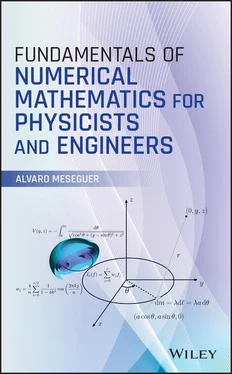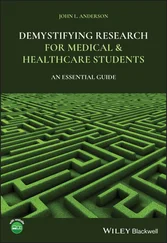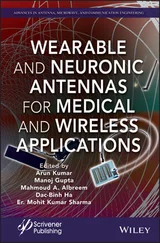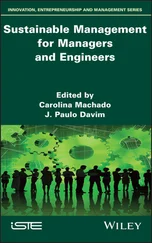Alvaro Meseguer - Fundamentals of Numerical Mathematics for Physicists and Engineers
Здесь есть возможность читать онлайн «Alvaro Meseguer - Fundamentals of Numerical Mathematics for Physicists and Engineers» — ознакомительный отрывок электронной книги совершенно бесплатно, а после прочтения отрывка купить полную версию. В некоторых случаях можно слушать аудио, скачать через торрент в формате fb2 и присутствует краткое содержание. Жанр: unrecognised, на английском языке. Описание произведения, (предисловие) а так же отзывы посетителей доступны на портале библиотеки ЛибКат.
- Название:Fundamentals of Numerical Mathematics for Physicists and Engineers
- Автор:
- Жанр:
- Год:неизвестен
- ISBN:нет данных
- Рейтинг книги:5 / 5. Голосов: 1
-
Избранное:Добавить в избранное
- Отзывы:
-
Ваша оценка:
Fundamentals of Numerical Mathematics for Physicists and Engineers: краткое содержание, описание и аннотация
Предлагаем к чтению аннотацию, описание, краткое содержание или предисловие (зависит от того, что написал сам автор книги «Fundamentals of Numerical Mathematics for Physicists and Engineers»). Если вы не нашли необходимую информацию о книге — напишите в комментариях, мы постараемся отыскать её.
Fundamentals of Numerical Mathematics for Physicists and
Engineers
Provides a modern perspective of numerical mathematics by introducing top-notch techniques currently used by numerical analysts Contains two parts, each of which has been designed as a one-semester course Includes computational practicals in Matlab (with solutions) at the end of each section for the instructor to monitor the student's progress through potential exams or short projects Contains problem and exercise sets (also with solutions) at the end of each section is an excellent book for advanced undergraduate or graduate students in physics, mathematics, or engineering. It will also benefit students in other scientific fields in which numerical methods may be required such as chemistry or biology.


 intercepting ordinates
intercepting ordinates  and
and  at abscissas
at abscissas  and
and  , respectively. (b) Roots of the equation
, respectively. (b) Roots of the equation  for
for  (solid black curve),
(solid black curve),  (dashed gray), and
(dashed gray), and  (solid gray).
(solid gray). is more sensitive (or ill‐conditioned) than the simple root
is more sensitive (or ill‐conditioned) than the simple root  . This phenomenon could have been predicted in advance just by evaluating the denominator
. This phenomenon could have been predicted in advance just by evaluating the denominator  appearing in ( 1.22) with
appearing in ( 1.22) with  and
and  or
or  , since
, since  , whereas
, whereas  .
.
 and
and  are the size of the variations introduced in the input data and their corresponding deviation effect in the outcome solution, respectively, and
are the size of the variations introduced in the input data and their corresponding deviation effect in the outcome solution, respectively, and  is a positive constant known as the condition number of the problem. The quantity
is a positive constant known as the condition number of the problem. The quantity  may represent uncertainties in the parameters, numerical noise or, within the context of this book, numerical inaccuracies due to limited machine precision. The condition number
may represent uncertainties in the parameters, numerical noise or, within the context of this book, numerical inaccuracies due to limited machine precision. The condition number  must be understood as a noise amplifier , which magnifies small uncertainties. A condition number of order 1 is an indication of well‐conditioning , whereas a problem with
must be understood as a noise amplifier , which magnifies small uncertainties. A condition number of order 1 is an indication of well‐conditioning , whereas a problem with  is definitely ill‐conditioned .
is definitely ill‐conditioned . as the displacement exhibited by the root,
as the displacement exhibited by the root,  as the numerical uncertainty in the evaluation of
as the numerical uncertainty in the evaluation of  , and
, and
 . As we will see in Section 1.6, the performance of Newton's method can be affected if the root we are looking for is ill‐conditioned.
. As we will see in Section 1.6, the performance of Newton's method can be affected if the root we are looking for is ill‐conditioned. , as in Figure 1.2a.
, as in Figure 1.2a. , secant has
, secant has  , etc.) In actuality, the order also depends on the conditioning of the root to which our sequence approaches. For example, the asymptotic constant from Newton's method
, etc.) In actuality, the order also depends on the conditioning of the root to which our sequence approaches. For example, the asymptotic constant from Newton's method  appearing in ( 1.16) is proportional to
appearing in ( 1.16) is proportional to  . As a consequence, if
. As a consequence, if  is a double root and, accordingly,
is a double root and, accordingly,  , the convergence criterion ( 1.11) is no longer valid since
, the convergence criterion ( 1.11) is no longer valid since  is not bounded. 11
is not bounded. 11










